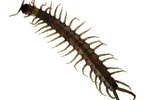
More than 2,000 species of mites exist, so it's no surprise that the insects come in all shapes, sizes and colors. But there is no mite quite like the red velvet mite. Because of their unique color and consistency, red velvet mites instantly catch the eyes of humans and animals alike. The mites are also called rain bugs because of their tendency to appear after a rainy day or evening.
A Velvet Appearance
Red velvet mites are known for their bright red color and their velvety coat of fine hairs. The insects are large compared with their fellow mite species. They range in size from 5 to 6 millimeters. The mites have eight legs and fanglike mouth parts similar to those of spiders. Scientists suspect that the red hairs on red velvet mites act as sensors, helping them navigate their surroundings. The related giant red velvet mites, larger mites primarily live in the Southwest. They can grow up to a half-inch in size. Their deep red color announces to predators that they are distasteful or poisonous.
Mite at Home
Red velvet mites typically live in the soil and remain underground for most of the year. They tend to emerge after spring rains to feed on prey that appear in significant numbers after rainstorms. Adult red velvet mites typically feast on termites and small spiders, while mite larvae are known to be parasitic on grasshoppers. Red velvet mites are usually visible for only several weeks out of the year. Because the mites live so close to fungi and bacteria, their bodies secrete antifungal oil that keeps the insects healthy and able to live within such toxins.
Mighty Reproduction
Red velvet mites have a unique way of breeding. Adult male mites start by depositing sperm on small twigs or stalks. The male mite then spins an intricate silken trail to the sperm. Female mites spot these threads and seek out the males who left them. If they are attracted, they will sit on and pick up the sperm, then release the eggs into the soil. If another male red velvet mite spots the sperm garden, he will destroy the silken trail and replace it with his own. Young red velvets go through several stages of molting before becoming adults.
An Environmental Friend
Red velvet mites benefit humanity. They are part of a family of soil arthropods that aid the ecosystem. By feeding on smaller insects, red velvet mites keep the numbers of invasive insects in check and prevent them from destroying vegetation. In addition, eating insects that feed on bacteria and fungi extends the the life of bacteria and fungi, which are among the most important decomposers of organic waste in soil ecosystems.
References
Resources
Photo Credits
-
Leonard Mc Lane/Photodisc/Getty Images
Writer Bio
Alicia Gallegos is a journalist in northwestern Indiana. She previously wrote for the "American Medical News, "a Chicago-based health newspaper published by the American Medical Association. She began her career at the South Bend Tribune, where she covered public safety, courts, food safety, education and health care.




